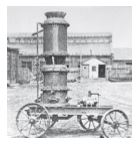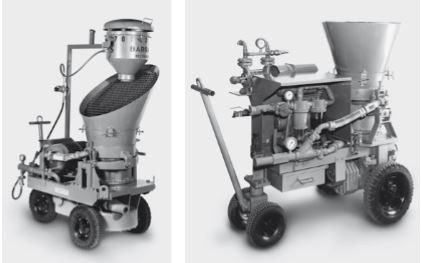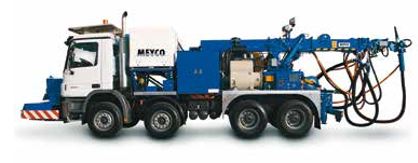History of sprayed concrete
The history of sprayed concrete is directly related to the limitations of the application of conventional cast concrete. Concrete is surely the most versatile construction material in use worldwide. Since concrete is strong enough in compression, it forms the basic material for most massive structures. Before concrete starts to set, its fluidity allows it to assume the most complex geometries or shapes. With the addition of reinforcement, every element of a structure can be formed from concrete. The only drawback to the use of concrete is the need for formwork or shutters, which are required to create a casting mould for the concrete as long as it is in a fluid state
Sprayed concrete, like many new products, was developed in the 19th century to meet specific, individual needs. In 1895 Dr Carlton Akeley, the curator at the Field Museum of Natural Science in Chicago, USA, was looking for a way to create models of prehistoric animals. The manufacture of a skeleton frame had been successful, but the body shapes could not be formed using conventional trowelled mortars.
The development of a device was required to enable the mortar mixture to be sprayed. Dr Akeley succeeded in developing a single chamber pressure vessel which contained a mixture of cement and sand. Under the pressure of compressed air, the mixture was forced through an opening and along a delivery hose. A nozzle, which was equipped with a water spray, was placed at the end of the hose. The mixture was hydrated when passing through this spray.
The equipment developed by Dr Akeley was known as the “Cement Gun” and the sprayed material was named “Gunite”. In 1911 the methods were patented and taken over by the Cement Gun Company.

Figure 1-1: Early machine for dry-mix sprayed concrete, Oakley 1900
During the use of the early machines a dry mix of sand and cement was placed into the pressurized chamber. The mix was then conducted from the chamber to a nozzle where water was added.
This method was therefore labeled the “dry process”. At the same time as the dry process was being developed, the “True Gun” method evolved. In this technique, sand and cement had to be fully mixed with water before being pumped through a completely different machine.
This method, which became known as the “wet process” due to the difference in mixing, was not fully developed commercially until the later part of the 1970s when Norwegian contractors developed machines able to apply wet sprayed concrete robotically in tunneling projects.


Figure 1-3: Modern sprayed concrete manipulator (MEYCO Roadrunner)
Sprayed concrete was initially used to repair reinforced concrete. Thanks to its advantages, sprayed concrete was soon adopted for new-build construction. Nowadays, the use of sprayed concrete for structural repair, fire protection, tunnel and refractory linings and other structures (e.g. river walls, domes, shell structures etc.) is common.
In the early days, sprayed concrete was not a high-quality product. To achieve sufficient adherence of the sprayed concrete to the excavated ground, large quantities of aggressive accelerating additives were needed. The resulting environmental conditions for workers, especially in the confined space of a tunnel, were very unhealthy because of the nature of the additives and the large quantity of dust produced during application. Furthermore, the quality of sprayed concrete varied a lot and its final strengths were much lower than those of conventional cast concrete.
Today sprayed concrete is accepted and used worldwide , and alkali-free accelerators in particular have contributed to a much safer and healthier working environment. Sprayed concrete allows the construction of complex shapes and structures without the high costs associated with formwork. If installed properly by experienced applicators, sprayed concrete provides designers with a cost-effective and flexible method to create and repair concrete structures.

